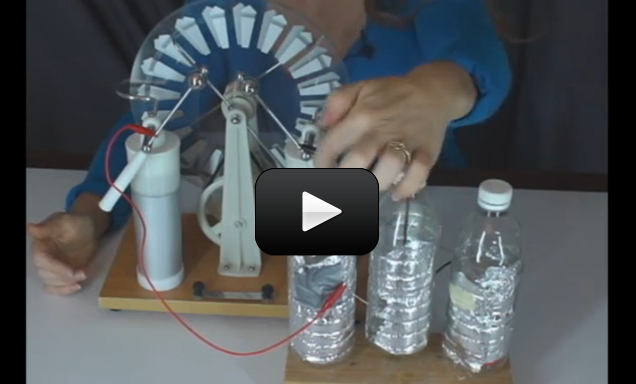You can use the idea that like charges repel (like two electrons) and opposites attract to move stuff around, stick to walls, float, spin, and roll. Make sure you do this experiment first.
I’ve got two different videos that use positive and negative charges to make things rotate, the first of which is more of a demonstration (unless you happen to have a 50,000 Volt electrostatic generator on hand), and the second is a homemade version on a smaller scale.
Did you know that you can make a motor turn using static electricity? Here’s how:
Please login or register to read the rest of this content.


THAT IS OUT OF THIS WORLD!!!!!!!!!!!!!!!!!!!!!
That’s right – you can rub a balloon and stick it to the wall, but why does that work? The wall isn’t positively charged, is it? Nope… the wall is not charged at all. It’s electrically neutral. However, when you bring a negatively charged balloon near it, two important things happen: the negative charge on the balloon repels the negative charges in the wall, pushing them further away. At the same time, the positive charges in the wall are attracted to the balloon and move toward it. The result is that the balloon sticks to the wall, and you have just moved charges around in the wall without even realizing it. Polarization means that you separate the charges in an object. The wall became polarized when you brought the balloon close to it.
You can read more about it here in the advanced physics section if you have the upper level membership.
The experiment was cool.Why does static electricity stick to something even if the thing it is sticking to is not charged?
We used firefox at first and couldn’t get the video to start. After changing it to safari it worked! Thank you for your speedy response, really appreciate it.
The video works over here… what browser and version are you using? And what happens if you try a different computer?
The video still doesn’t work.
Oops… sorry about that. I’ve fixed it so you can try it now.
I can’t make the Wimshurst machine the link is closed 🙁 O:(
Here’s a cool video from a student (Colin) of the electrostatic experiment, but modified:
It’s really hard to build a Wimshurst machine that works well… I recommend purchasing one from a science supplier. I actually have this one and like it a lot – the sparks are big enough to use in a classroom on a dry day. I set this up in my classes for kids to shock themselves and they always have such a great time.
NOTE: If you have anyone in your house with a pacemaker or other condition (this includes all pregnant women and babies), DO NOT use one of these machines – it produces enough of a jolt to adversely affect their heart. For healthy people, the volts and amps are way below the hazard threshold.
How do we build the advanced electrostatic machine? Do you have instructions on the website?
Yes, that can happen in higher-humidity locations. Maybe in the wintertime? 🙂
we tried but it did work. I think it is too humid where we live to do this… have to wait until we turn the heater on inside…
Whoops! Sorry about that… we recently moved things around in the background, and looks like we missed updating this link. Thanks for your eagle eye! All fixed now.
“You can use the idea that like charges repel (like two electrons) and opposites attract to move stuff around, stick to walls, float, spin, and roll. Make sure you do this experiment first.”
The link to the experiment mention above (under Advanced Static Electricity Experiments) is not working.